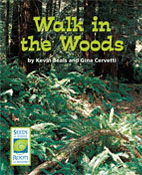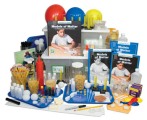Archive for March, 2013
Students Can Celebrate National Walking Day with a “Walk in the Woods”
 April 3, 2013 is National Walking Day. The day was created to raise awareness of the importance of physical activity. One type of physical activity that can be a learning experience for students is a walk in the woods. When students walk in the woods, they notice lots of things. In the Seeds of Science/Roots of Reading® book Walk in the Woods, students “accompany” a soil scientist named Asmeret as she walks through the woods. Students see the world through a soil scientist’s eyes as Asmeret searches for evidence of decomposition. As Asmeret guides students through the forest, several important ideas emerge: soil is made of living and non-living things; small organisms help decompose dead plants and animals; and through decomposition, soil is made. It shows how scientists look for evidence to help answer questions about the world.
April 3, 2013 is National Walking Day. The day was created to raise awareness of the importance of physical activity. One type of physical activity that can be a learning experience for students is a walk in the woods. When students walk in the woods, they notice lots of things. In the Seeds of Science/Roots of Reading® book Walk in the Woods, students “accompany” a soil scientist named Asmeret as she walks through the woods. Students see the world through a soil scientist’s eyes as Asmeret searches for evidence of decomposition. As Asmeret guides students through the forest, several important ideas emerge: soil is made of living and non-living things; small organisms help decompose dead plants and animals; and through decomposition, soil is made. It shows how scientists look for evidence to help answer questions about the world.
Students might be amazed to learn that everything in the woods could become part of the soil. The rocks, the leaves and wood, and even the animals could become soil someday. When organisms decompose, they make rich soil. Rich soil has lots of nutrients. Plants need these nutrients to grow,
Students can witness decomposition if they look closely. Trees show evidence of decomposition.
Leaves also show signs of decomposition.
Students may ask how dead plants and animals become soil. The answer may sound strange, but other organisms make them into soil. These organisms are called decomposers. Decomposers break dead things down into soil. They add nutrients to the soil. Here are a few examples of decomposers.
Everything that is living will die one day. Decomposers will break it all down into soil. Now that students understand the important role of decomposers, it may be hard for them to imagine a forest without them. How soil is created may just be one of the questions students have during a walk in the woods. As they find new things, they may be encouraged to research the answers to their questions. They are then acting like scientists. We hope they get their hands dirty and investigate!
For more information about the student book Walk in the Woods and the Soil Habitats science and literacy unit, visit http://www.scienceandliteracy.org.
Do you want to be notified when we publish new blog articles? Simply enter your email address in the “Follow Blog via Email” box located in the right sidebar.
Ecosystem Awareness for Students: A Visit to a Pond
Ponds may look peaceful, but they are full of buzzing, swimming, creeping life. Some ponds are half the size of a soccer field and you could walk the perimeter in a matter of minutes. However, close observations can reveal a fascinating world of organisms. All living organisms need water. Plants grow where there is water, and animals tend to live around plants. This is why a visit to a pond can be an engaging activity for students. Below is information you can provide to students about what they might see on a walk around a typical pond.
 In the Seeds of Science/Roots of Reading® student book Visit to a Pond, many of the environmental factors about ponds are described (where the water comes from, how much sunlight it gets) as well as many of the typical members of a pond community (birds, visiting mammals, insects, turtles, and fish). This book is particularly useful for students who may not live near a pond. It can also answer questions and reinforce concepts for students who have explored a pond in person.
In the Seeds of Science/Roots of Reading® student book Visit to a Pond, many of the environmental factors about ponds are described (where the water comes from, how much sunlight it gets) as well as many of the typical members of a pond community (birds, visiting mammals, insects, turtles, and fish). This book is particularly useful for students who may not live near a pond. It can also answer questions and reinforce concepts for students who have explored a pond in person.
Decomposing
Edges of the pond often muddy, usually as a result of rain. Leaves can be observed decomposing in the mud, slowly turning into dirt. Decompose means to break down into smaller and smaller parts.
Evidence
Students might use evidence to determine what took place in and around a pond. In the photograph below, they can see the muddy dirt trail is covered in animal tracks. They look like handprints from the paws of a raccoon. Raccoons are mostly active at night. During the day, these tracks are the only evidence that raccoons have been here. Evidence are clues that help explain or answer a questions.
Predator
Floating near the surface are aquatic plants that don’t need soil. Many small animals in the pond use aquatic plants as food and shelter. Pond snails crawl along plants underwater, eating the plants as they go. The plants also give the snails a safe place to hide from predators. A predator is an animal that hunts and kills other animals.
Prey
Students might catch a glimpse of a frog floating at the surface of the water where it can breathe air while waiting for prey. If an insect comes too close, it may be caught by the frog’s long, sticky tongue. Prey is an animal that is hunted and eaten for food.
Pond organisms
If they’re lucky, students might catch a glimpse of one or more of the following organisms while visiting a pond. These are also featured in student book Visit to a Pond.
- Dragonflies
- Ducks
- Kingfishers
- Fish
- Water striders
- Turtles
- Great blue herons
- Snakes
- Water boatman
While a pond may seem calm, it is rich and full of life. There is a world of constant motion – of eat and be eaten, of swim and fly, of creep and crawl. We encourage you and your students to take the time to pay close attention so you’ll begin to see organisms and notice patterns.
For more information about the student book Visit to a Pond and the Aquatic Ecosystems science and literacy unit, visit http://www.scienceandliteracy.org.
Do you want to be notified when we publish new blog articles? Simply enter your email address in the “Follow Blog via Email” box located in the right sidebar.








